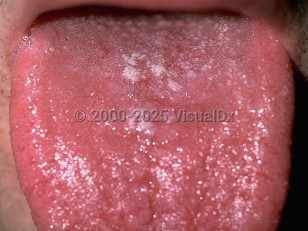Oral candidiasis in Adult
See also in: Oral Mucosal LesionAlerts and Notices
Important News & Links
Synopsis

Risk factors include hyposalivation states leading to dry mouth (especially medication-related xerostomia and xerostomia related to head or neck radiation), antibiotic therapy, oral leukoplakia, a carbohydrate-rich diet, medications such as inhaled or topical corticosteroids, fluid and electrolyte imbalance, smoking, endocrine disorders (diabetes mellitus, Addison disease, hypothyroidism), immunosuppression, and nutritional deficiencies (including iron, zinc, magnesium, selenium, folic acid, and vitamins A, B6, B7, B12, and C). For angular cheilitis, dentures that do not adequately support the oral musculature, causing drooping of the corners of the mouth and pooling of saliva, may predispose.
Patients may complain of a sore, sensitive, or burning sensation. Itching has also less frequently been described. Others may be wholly asymptomatic.
Pseudomembranous candidiasis (thrush) usually develops fairly rapidly over a few days, while the erythematous and hyperplastic forms tend to be chronic and present for weeks or months.
Candida albicans is the most commonly implicated species in oral candidiasis. Species of Candida that are occasional causes of disease, particularly in patients with AIDS and patients with a history of head and neck radiation, are Candida glabrata (formerly known as Torulopsis glabrata), Candida tropicalis, Candida krusei, Candida dubliniensis, and others.
Immunocompromised patient considerations: Oral candidiasis is seen with greater frequency in patients with leukemia or other malignancies, individuals with AIDS, and individuals receiving immunosuppressive agents (eg, systemic corticosteroids, azathioprine, cyclosporine A, or tacrolimus). Patients with diabetes are also predisposed. Risk factors for oral candidiasis in the HIV-infected population include low CD4 count (< 200 cells/microl), being antiretroviral naïve, and current smoking. Laryngeal and/or esophageal involvement may occur in concert with oral candidiasis in patients who are immunocompromised. Isolated laryngeal involvement has been reported from inhaled corticosteroids.
Codes
B37.0 – Candidal stomatitis
SNOMEDCT:
79740000 – Candidiasis of mouth
Look For
Subscription Required
Diagnostic Pearls
Subscription Required
Differential Diagnosis & Pitfalls

Subscription Required
Best Tests
Subscription Required
Management Pearls
Subscription Required
Therapy
Subscription Required
Drug Reaction Data
Subscription Required
References
Subscription Required
Last Updated:05/04/2025
 Patient Information for Oral candidiasis in Adult
Patient Information for Oral candidiasis in Adult- Improve treatment compliance
- Reduce after-hours questions
- Increase patient engagement and satisfaction
- Written in clear, easy-to-understand language. No confusing jargon.
- Available in English and Spanish
- Print out or email directly to your patient


